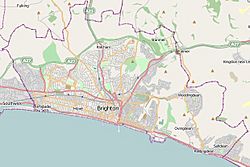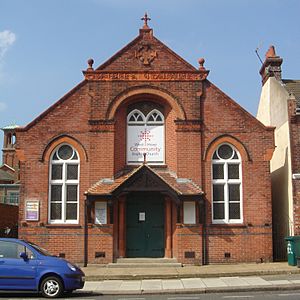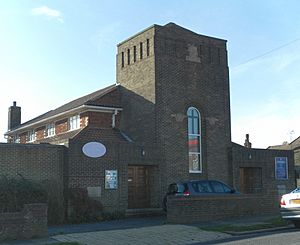Hounsom Memorial United Reformed Church, Hove facts for kids
Quick facts for kids Hounsom Memorial Church |
|
|---|---|
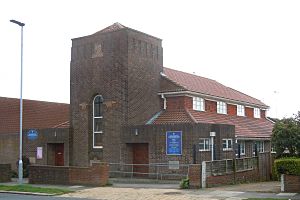
The church from the northwest
|
|
| 50°50′39″N 0°11′33″W / 50.8443°N 0.1925°W | |
| Location | Nevill Avenue, Brighton and Hove BN3 7NG |
| Country | England |
| Denomination | United Reformed Church |
| Previous denomination | Congregational |
| History | |
| Status | Church |
| Founded | 16 March 1938 |
| Founder(s) | Sussex Pioneers |
| Dedicated | 22 October 1939 |
| Architecture | |
| Functional status | Active |
| Architect(s) | John Leopold Denman |
| Style | Vernacular/Neo-Georgian |
| Groundbreaking | 16 March 1938 |
| Completed | 17 September 1939 |
| Construction cost | £2,700 |
| Specifications | |
| Capacity | 350 |
| Materials | Red and brown brick; tiles |
| Administration | |
| Synod | Southern Synod |
The Hounsom Memorial Church is a United Reformed place of worship in Hove, a city in England. It is one of six churches of this Christian group in the city. The church was built in 1938 for the Congregational Church. This group later became part of the United Reformed Church in 1972.
The church is named after William Allin Hounsom. He was a local man and a long-time member of the Congregational Church in central Hove. He had many business interests and owned land across Sussex. The building is made of red brick. It was designed by John Leopold Denman, a famous architect from Brighton. The church has special carvings that are quite surprising for a Nonconformist church.
Contents
History of the Church
Hove was once a small village. It grew very quickly in the 1800s as a place for people to live. This happened because nearby Brighton was also growing fast. The Union Chapel in Brighton, which started in the 1600s, began to help people in Hove in 1823. Some members started a Sunday school and a temporary worship place.
The number of people attending grew. In 1861, land was bought for a permanent church in Cliftonville, a fast-growing area of Hove. This church, called Cliftonville Congregational Church, opened in 1870. It was the first Nonconformist church in the town.
Growth and Support
The church became more important locally. In 1899, it opened a mission church called Rutland Hall in the Aldrington area of Hove. William Allin Hounsom (1848–1934) was a major helper for this new church. He was a long-time member of Cliftonville Congregational Church. He helped raise money, gave land, and donated a house.
Hounsom was known as a strong supporter of Congregationalism. He also gave money to start a Congregational chapel in Horsted Keynes in West Sussex. He owned a lot of land in different parts of Sussex. He passed away on January 28, 1934. Meanwhile, Rutland Hall faced problems. It was used for wartime purposes, and many men from the church joined the army.
Building the New Church
Between World War I and World War II, Hove grew rapidly. New homes were built, especially northwards towards the South Downs. Areas like Hangleton grew very fast after 1928. By 1935, many houses covered a large area.
In the early 1930s, a group called the Sussex Pioneers was formed. They wanted to find places to build new Congregational churches. William Allin Hounsom was part of this group. Hangleton was chosen as a perfect spot because it was growing quickly and had no Nonconformist church yet.
In 1936, the Sussex Pioneers suggested that Cliftonville Congregational Church should start a new church there. Both churches and the Sussex Congregational Union began raising money. Cliftonville Church made the biggest contribution by selling Rutland Hall for £2,000. The church members also raised another £1,000.
Several locations in Hangleton were considered. Nevill Avenue was chosen because the church could be set back from the road in a quiet spot. Around this time, Rev. Jason S. Wright became the minister of the new church. Two local people started a Sunday school in their home. They visited people and shared information about the church. Many people became interested in attending services.
Founding and Opening
The name Hounsom Memorial Church was chosen to remember William Allin Hounsom. The church was officially founded on March 16, 1938. At the ceremony, three foundation stones were laid. Other Christian groups, like The Salvation Army, also took part.
Cliftonville Church formed a committee to manage the building work and the new church. John Leopold Denman, a well-known architect, was chosen to design the church. He planned a modern building with aisles and clerestory windows. The church was built by Braybon & Son, a local company.
The Hounsom Memorial Church opened for worship on September 17, 1939. The first service was led by J. Ernest James. The church had 70 members when it opened. It was officially recognized as a Congregational church on October 22, 1939. It was also registered for marriages on November 8, 1939. The church quickly became independent from Cliftonville Church.
The new church had its own schoolroom. This helped the Sunday school grow a lot. By 1939, there were 98 members. More children joined during the war when people moved from London to Hangleton.
Post-War Growth and Activities
During World War II, the church faced money problems. But with help from grants, it was debt-free by July 1947. The church then started raising money for a church hall. The £500 needed was raised by May 1948. Construction began on a site east of the church.
The hall was finished in 1951. John Leopold Denman also designed this building. Having its own hall helped many church groups grow. These included a Women's Fellowship (1938), Girls' Brigade (1939), Boys' Brigade (1941), and a Young People's Fellowship (1943). The hall also served as Hangleton's first community center and library.
The church also started "Dramatic Services" in 1945. These were worship services in the form of plays. They attracted people from all over Brighton and Hove. The church also showed religious films.
The church bought a Kawai grand piano with money left to them. In April 1990, the famous singer Tony Bennett was going to perform at the Brighton Dome. He accidentally broke the venue's piano during his warm-up. Someone remembered the Hounsom Memorial Church's piano. It was brought to the Dome just in time for Bennett's show.
Becoming a United Reformed Church
In 1972, Hounsom Memorial Church joined the United Reformed Church. This happened when most Congregational and Presbyterian churches in England came together. It is now a "local congregation" of this group. It is one of six United Reformed Churches in Brighton and Hove.
Other churches include the former Cliftonville Congregational Church (now Central United Reformed Church). There are also churches at North Road, Lewes Road, Portslade, and Saltdean. In the 1950s, there were ideas to change the church's name to St Christopher's Church. This was because of a carving of Saint Christopher on the front of the building. However, this change never happened.
The church is officially registered for worship. Its registration number is 58318.
Architecture of the Church
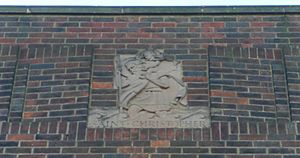
The people who founded the church gave John Leopold Denman clear instructions. They wanted a modern building that fit the area. They did not want it to look like an old 15th-century church or a typical Nonconformist chapel.
Denman's design combines elements of Vernacular (local, traditional) and his favorite Neo-Georgian style. It also has some Modernism. The church can hold 350 people. It has one large open space inside. This space is lit by small clerestory windows high up near the roof.
The walls are made of "mottled" red brick from the Ringmer brickworks. The red roof tiles also came from there. A short tower stands at the north end. It has a shallow, tiled spire. This tower features three "startling" bas-relief carvings. These carvings show Saint Christopher, a pelican, and a lamb. The pelican and lamb represent sacrifice and the Lamb of God. These kinds of symbolic carvings are unusual for a Nonconformist church.
See also


